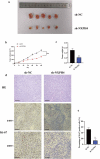Neurexophilin 4 is a prognostic biomarker correlated with immune infiltration in bladder cancer
- PMID: 35758021
- PMCID: PMC9276049
- DOI: 10.1080/21655979.2022.2085284
Neurexophilin 4 is a prognostic biomarker correlated with immune infiltration in bladder cancer
Abstract
Recent studies have shown that NXPH family member 4 (NXPH4) plays an important role in the progression of cancer. However, the potential role of NXPH4 in bladder cancer (BCa) remains to be explored. The purpose of the present study was to identify whether NXPH4 could be used as a biomarker to predict the prognosis of BCa. We first examined the expression of NXPH4 in pan-cancer, and then focused on BCa. Univariate and multivariate Cox regression analysis were used to investigate whether NXPH4 could be used as an independent prognostic indicator. Gene set enrichment analysis (GSEA) was used for functional analysis of NXPH4-related genes. CIBERSORT algorithm was used to calculate immune cell infiltration levels with different NXPH4 expression. Finally, the expression of NXPH4 was validated in clinical tissue specimens and bladder cancer cell lines by immunohistochemistry and qRT-PCR. The tumor-promoting effects of NXPH4 were further investigated using counting kit-8 (CCK-8), colony formation, EdU assays, and tumor xenograft model. Our results showed that NXPH4 was highly expressed in BCa tissues. Patients in the high NXPH4 expression group had shorter overall survival (OS) and progression-free survival (PFS). We found that immune-related pathways were enriched in NXPH4-related genes. Immune cell infiltrations in BCa were also associated with different NXPH4 expression. NXPH4 was further found to be highly expressed in our validation specimens. The proliferative effect of NXPH4 was confirmed in BCa in vivo and in vitro. Overall, NXPH4 is a biomarker for predicting BCa prognosis and associated with immune infiltration.Abbreviations: NXPH4: Neurexophilin 4; BCa: Bladder cancer; TCGA-BLCA: The Cancer Genome Atlas Urothelial Bladder Carcinoma; shRNA: short hairpin RNA; NC: Negative control; OS: Overall survival; PFS: Progression-free survival; TME: Tumor microenvironment; IPS: immunophenoscore; ICIs: Immune checkpoint inhibitors; DEGs: Differential expression genes.
Keywords: Bladder cancer; NXPH4; immune infiltration; prognosis; progression.
Conflict of interest statement
No potential conflict of interest was reported by the author(s).
Figures









Similar articles
-
Tumor suppressing function of SLC16A7 in bladder cancer and its pan-cancer analysis.BMC Cancer. 2025 May 23;25(1):932. doi: 10.1186/s12885-025-14345-z. BMC Cancer. 2025. PMID: 40410718 Free PMC article.
-
NXPH4 can be used as a biomarker for pan-cancer and promotes colon cancer progression.Aging (Albany NY). 2024 Apr 12;16(7):5866-5886. doi: 10.18632/aging.205648. Epub 2024 Apr 12. Aging (Albany NY). 2024. PMID: 38613793 Free PMC article.
-
Identification of a tumor microenvironment-related seven-gene signature for predicting prognosis in bladder cancer.BMC Cancer. 2021 Jun 10;21(1):692. doi: 10.1186/s12885-021-08447-7. BMC Cancer. 2021. PMID: 34112144 Free PMC article.
-
Expression profiles, biological functions and clinical significance of circRNAs in bladder cancer.Mol Cancer. 2021 Jan 4;20(1):4. doi: 10.1186/s12943-020-01300-8. Mol Cancer. 2021. PMID: 33397425 Free PMC article. Review.
-
The Role of Checkpoint Inhibitor Expression Directly on Exfoliated Cells from Bladder Cancer: A Narrative Review.Diagnostics (Basel). 2023 Oct 3;13(19):3119. doi: 10.3390/diagnostics13193119. Diagnostics (Basel). 2023. PMID: 37835862 Free PMC article. Review.
Cited by
-
Machine-learning prediction of a novel diagnostic model using mitochondria-related genes for patients with bladder cancer.Sci Rep. 2024 Apr 23;14(1):9282. doi: 10.1038/s41598-024-60068-9. Sci Rep. 2024. PMID: 38654047 Free PMC article.
-
Current look at the most promising proteomic and glycomic biomarkers of bladder cancer.J Cancer Res Clin Oncol. 2024 Feb 19;150(2):96. doi: 10.1007/s00432-024-05623-7. J Cancer Res Clin Oncol. 2024. PMID: 38372785 Free PMC article. Review.
-
An immunogenic cell death-related lncRNA signature correlates with prognosis and tumor immune microenvironment in bladder cancer.Sci Rep. 2024 Jun 7;14(1):13106. doi: 10.1038/s41598-024-63852-9. Sci Rep. 2024. PMID: 38849410 Free PMC article.
-
An m6A-Driven Prognostic Marker Panel for Renal Cell Carcinoma Based on the First Transcriptome-Wide m6A-seq.Diagnostics (Basel). 2023 Feb 21;13(5):823. doi: 10.3390/diagnostics13050823. Diagnostics (Basel). 2023. PMID: 36899967 Free PMC article.
-
High expression of NXPH4 correlates with poor prognosis, metabolic reprogramming, and immune infiltration in colon adenocarcinoma.J Gastrointest Oncol. 2024 Apr 30;15(2):641-667. doi: 10.21037/jgo-23-956. Epub 2024 Apr 29. J Gastrointest Oncol. 2024. PMID: 38756632 Free PMC article.
References
-
- Antoni S, Ferlay J, Soerjomataram I, et al. Bladder cancer incidence and mortality: a global overview and recent trends. Eur Urol. 2017;71(1):96–108. - PubMed
-
- Chen W, Zheng R, Baade PD, et al. Cancer statistics in China, 2015. CA Cancer J Clin. 2016;66(2):115–132. - PubMed
-
- Kimura T, Ishikawa H, Kojima T, et al. Bladder preservation therapy for muscle invasive bladder cancer: the past, present and future. Jpn J Clin Oncol. 2020;50(10):1097–1107. - PubMed
MeSH terms
Substances
LinkOut - more resources
Full Text Sources
Other Literature Sources
Medical
Molecular Biology Databases
